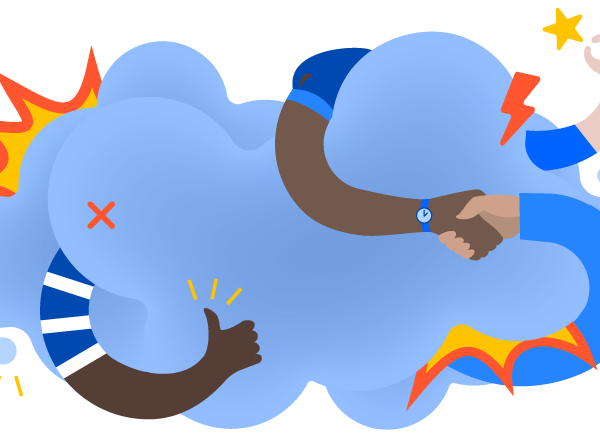5-second summary
- Team cohesion is an important component of high-performing teams.
- Too much team cohesion can mean that individuals focus on coming to an agreement rather than finding the best idea.
- Encouraging a culture of healthy dissent can help prevent this – but only if team members feel psychologically safe.
Whether you love to cook (like I do) or you just love to eat, you probably know that recipes are all about balance. Too much of one thing – even if it’s an ingredient you love – can throw off the rest of the dish. For example, one of my recent favourite recipes is the viral Tiktok pasta, which features feta cheese and garlic. Both are delicious, strong flavours. However, if you’re not aware of the correct proportions, either one could overwhelm the dish.
It’s the same for teams. In my work as a researcher, I study how the individual elements of collaboration, communication, and shared goal setting combine to form a cohesive whole.
What the research has shown is that, when it comes to teams, it’s possible to have too much of a good thing. Believe it or not, it is possible for teams to feel too connected.
TIP
Check out our State of Teams report to get the inside scoop on what makes teams healthy, productive, and innovative.
The most connected teams have the highest risk
Team cohesion seems like a good thing – and, in general, it is. It occurs when everyone on the team really likes one another, and feels a strong sense of connection to each other. A meta-analysis (a statistical analysis of multiple, independent scientific studies) demonstrated that team cohesion is significantly associated with higher levels of team performance.
This is because when everyone on the team is connected, team members are more likely to want to perform well. It also becomes a lot easier to communicate and cooperate with one another. Research shows that team cohesion is even more important in virtual teams, due to the challenges of connecting online vs. through in-person interactions.
But what happens, though, when there is too much team cohesion?
When team members like each other too much, they may conform to group norms just to blend in. In the book “Atomic Habits,” James Clear describes a study where chimpanzees learn a great method of cracking nuts as part of one group. However, if the chimpanzee switches over to another group that uses a less effective strategy, they will avoid using their better method just so they can blend in.
Similarly, team members in very cohesive teams may also shy away from voicing ideas that could potentially rock the boat. That is, these team members may tend to avoid constructive conflict about the tasks they are working on because they do not want to cause friction between each other. They may also be too quick to accept random ideas generated by their team, as opposed to brainstorming to try and find the most effective or original idea.
This phenomenon whereby team members avoid presenting better alternatives, voicing ideas that may rock the boat, critiquing existing ideas, or they simply conform to group norms, is known as “groupthink.” Groupthink is a phenomenon that occurs when a group abandons rational decision making in favor of consensus. When a team is experiencing groupthink, individuals may abandon their own beliefs in order to conform with the group.
Groupthink was coined by the psychologist Irving Janis, who was able to use this phenomenon to explain situations such as the attack on Pearl Harbor in 1941. Due to the potentially huge ramifications of groupthink, it has been extensively studied ever since the concept emerged.
Importantly, not all cohesive teams result in groupthink. Instead, the most cohesive teams are at greater risk of groupthink occurring. How can we mitigate this risk?
What’s the antidote to groupthink? Embracing healthy dissent
We can mitigate the risks of subpar decision making by encouraging a team culture of dissent. The idea that dissent is integral for highly effective teams is well-established. Research has demonstrated that when teams are exposed to a minority dissenting view, they become more creative in their thinking.
There is also a ton of research about the benefits of creating a team culture that values and supports innovation, by encouraging new ideas. A meta-analysis has demonstrated that a team culture that supports innovation (i.e., one that includes dissent and new ideas) is one of the strongest drivers of innovative outcomes.
Clearly, there are a lot of benefits to encouraging teams to have a culture that values divergent perspectives, new ideas, and dissent. Team leads can foster this culture by ensuring their team:
- Has regular time scheduled just for brainstorming
- Takes time to consider all ideas no matter how far-fetched
- Actually executed on the best ideas.
But again, there is a downside when a team takes this too far.
TIP
Use the Inclusive Meetings play from Team Playbook to help ensure everyone’s voice is heard during brainstorming sessions.
Dissent only works under the right conditions
Imagine you are in a team that really values new ideas, brainstorming, diverse perspectives, and dissent. There will evidently be a lot of disagreement about the best way to do things, or what the best ideas are. However, conflict and dissent only produce better outcomes under certain conditions.
For example, in one study, researchers investigated 117 undergraduate project teams. They found that conflict about the work only resulted in better performance when there was psychological safety in the team.
Another study demonstrated that when teams were engaged in brainstorming, constructive critique enhanced both the quantity and quality of ideas only if the teams felt as though they were in a psychologically safe and cooperative environment. When teams felt as though they were in a competitive environment, constructive critique actually reduced the quality and quantity of ideas.
Why was this the case? Because when team members feel psychologically safe, they interpret any criticisms of their ideas as constructive. They feel as though the team are aligned in their goals, so they know that when their ideas are critiqued, it is for the sake of the “greater good.” However, when teams feel as though they are in a competitive environment, they are less likely to trust that any criticism is for the sake of team goals. Criticism, in this context, would actually undermine creativity and innovation as it promotes mistrust and friction between team members.
The balancing act
The takeaway is that teams can only be effective when they balance having a culture of dissent and innovation with psychological safety and cohesion. A team cannot be effective if they like each other so much that they don’t want to voice their ideas so they don’t rock the boat. Likewise, a different team cannot be effective if they criticise each other’s ideas in the absence of psychological safety – this would just create mistrust and undermine performance.
A great team feels a strong sense of connection with one another, but also feels safe voicing different ideas and perspectives. This balance truly creates the perfect recipe for a highly effective team.









































